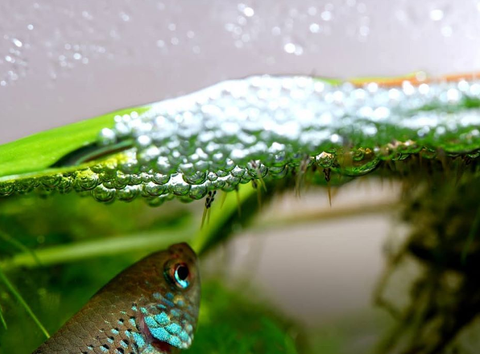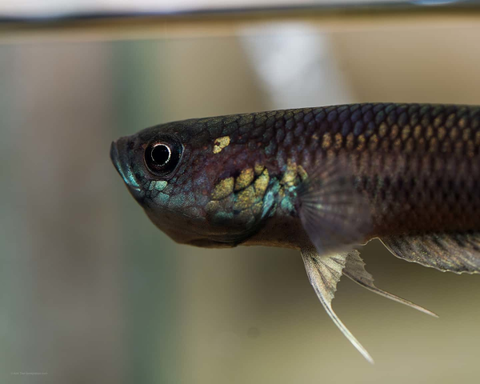Introduction to Wild Type Bettas for Beginners
Share
What are wild type bettas?
They are the lesser known types of bettas that occur in it’s natural form in the wild.
Most people have the impression that wild type bettas are difficult to keep, but they are not much different from any other fish at your local fish store. For beginners that are completely green to fish keeping in general, wild bettas MAY not be for you unless you are willing to do some research. The basic terminologies involved are a necessity, if you can understand this article, then you should be good to go.
We have been asked the question, “What is a good wild type betta to start with?” Our answer to them was always, “It depends.” That is because there are a large variety of bettas to choose from. Our first question to them had always been, “Do you prefer bubble-nesters or mouthbrooders?”
Bubble-nesters are fishes that create a nest of bubbles to lay their eggs in and raise, similar to that of their popular cousin, the domesticated Betta Splendens. Males will create a bubble nest and then entice the female to join him. When ready, the male will embrace the female and eggs will be laid. The males will then collect the eggs and place them in the nest. On some rare occasion, the female may help him.

Betta Smaragdina Guitar tending to his fry from his bubble nest.
Mouthbrooders on the other hand are completely different as the males will hold the eggs in his mouth until they are free swimming. The process is similar in where the male will embrace the female as she releases eggs and the male will then pick up the eggs and keep them in his mouth. The female may also help him pick them up as well, also on rare occasions.

Betta Unimaculata “Tarakan Yellow” with a mouth full of eggs as he holds them until they hatch.
We will talk more about breeding bettas another time.
Once they narrow that down, then we can ask about their preferable size and color.
For bubble-nesters, we would usually recommend any of the species in the Coccina complex. They are relatively smaller and less aggressive than those in the Splendens complex. However, still more aggressive than the Albimarginata complex. There are larger selections of bettas to choose from with a variety of different colors than there is in the mouthbrooders group and most of the fry can eat newly hatched baby brine shrimp off the bat. Splendens fry would require smaller foods, such as infusoria, paramecium, microworms, etc.
For beginners who would like to try mouthbrooders, we would recommend the Albimarginata Complex. Other considerations may be Rubras, Dennisyongi, Edithae, Falx, Dimidiata but they do get a bit bigger and thus, jump higher. These bettas are far less aggressive than the above species and a group or colony can be kept together in the right size tank. These species are the smallest type of all the mouthbrooders. The fry can eat baby brine shrimp immediately after being released.
Now, once you’ve selected the species and probably googled all the information you can find on them then you probably don’t need to continue reading this. But hey, if you want to see what we suggest… keep reading at your own risk. I may or may not keep it short. One thing you have to know is, WILD BETTAS JUMP! You should have a lid on your tank. For bettas in these complexes, you can probably get away with lowering your water level; 3 inches to be safe. For other species, keep a lid on it! Unimaculatas especially. They can and have, easily cleared 12 inches for us.
So now you’re going to need to build a home for these guys. What we suggest will only be for the species mentioned above.
Aquarium Size: A 5 gallon tank will be sufficient for a pair of these but if you have the room, a 10 gallon tank would be even better. A 10 gallon tank can host a small group of Betta Albimarginata or Channoides. Smaller tanks are better for breeding since they will see each other more often. Always keep an eye on your bettas in case one is too aggressive.
Substrates can be anything you want such as gravel, sand or aquarium soil, but a darker substrate brings out the betta’s color better as they feel more comfortable. We prefer to use some type of aquarium soil so we can grow plants in the tank as well. For our breeder setups, we do not use any soil as it will be easier to clean and move fishes around.
Water Chemistry is rather important, these bettas come from a blackwater biotope. Meaning the water is soft, full of tannins and can have relatively low pH(4.0-5.0). In your aquarium, the pH does not need to match and most of the beginner types can tolerate a wider range. We would recommend keeping their pH between 5.5-6.5. We use RO water with minerals(Seachem Equilibrium) added in to reach 60-80ppm on the TDS meter. Whatever it is, make sure to drip acclimate your bettas when you receive them!
Temperature in their native habit is around 78-80F(25-26C) year round. These would be ideal temperature to keep and breed them in. They can tolerate slightly lower or higher temperatures. After acclimation, make sure the temperatures match when introduced.
Lighting is not needed but if you do, try not to use bright lights and provide plenty of shade and cover. Low light plants will be ideal.
Décor can be anything you want, I would suggest whatever pleases you since the fish doesn’t really care if it’s a natural rock or Ariel from The Little Mermaid. Well, maybe the male bettas might prefer the latter. Anything for fishes to hide behind when they are stressed or being picked on by the others will work just fine. A nice heavily planted scape would always be ideal for the viewer and also providing plenty of cover for the more aggressive fishes.
Filtration can be as simple as a sponge filter since bettas prefer slower moving water. We use sponges in all of our betta tanks with weekly water changes.
Company for your betta should be similar sized fishes, they cannot be too small where the bettas will eat them, nor too big where the bettas become food. Also, they should not be too fast that they eat everything before your bettas can get to them. These fishes must also be able to tolerate soft acidic water.
Diet should consist of mainly live foods or dry foods with plenty of protein. Bettas are carnivores in nature and providing live food once in awhile would be great for your betta. If they see something moving, they will try to eat it. Smaller bettas can eat daphnia, baby brine shrimp and blackworms. Larger bettas can eat blackworms, nightcrawlers and small crickets or basically anything. They can be trained to eat dry pellets and flakes as well once they know everything you toss in is usually food. It may take some time. We try to train ours to eat dry food as well but we only hold them for so long before they find their new homes.

And there you have it, everything you need to know to choose and raise your first wild bettas! You can see the photos of the different types in the COCCINA COMPLEX and ALBIMARGINATA COMPLEX. The one big difference is that the Albimarginata complex are more peaceful than the Coccina complex. Overall, taking care of wild bettas are no different than any other fish at your local fish store, you should ALWAYS do your research before you buy any aquarium fish in order to ensure happy and healthy fishes. These are just some of our suggestions. There are many more out there for you. Feel free to chime in! Here at Blackwater Aquatics, we carry fishes that are usually unavailable at your local fish store as there aren’t a high demand for mainstream sales. Our main goal is to help you become successful in preserving and maintaining wild bettas. Feel free to ask us any questions on Facebook or Instagram or send us a message on our Contact Us page.
You can also leave us a comment or question below.

26 comments
yTrNPvfIjSVRazJM
ogUXTlpsVaOjL
IpNZVSAE
XDaEbwSYhq
dbOYDEfa